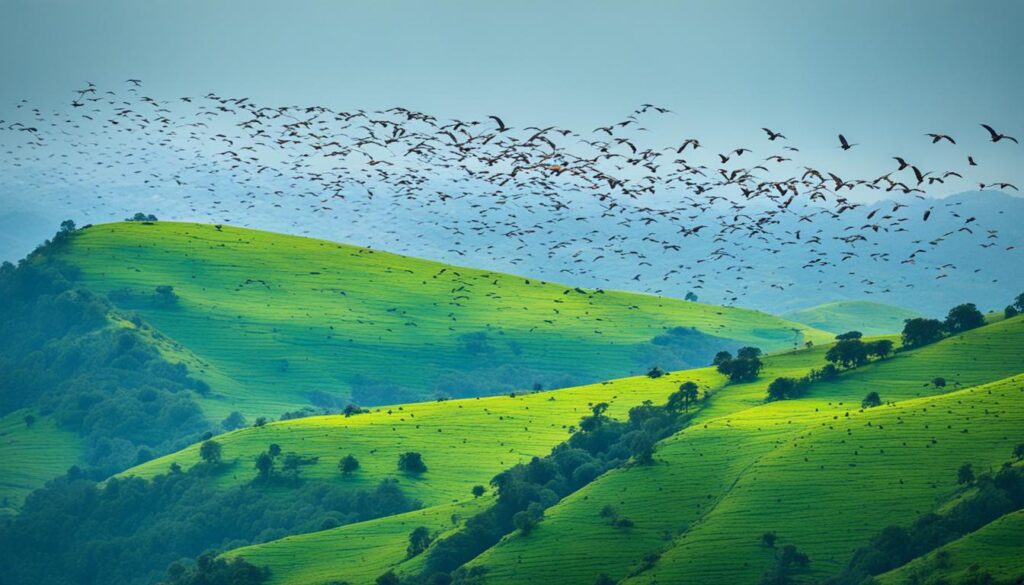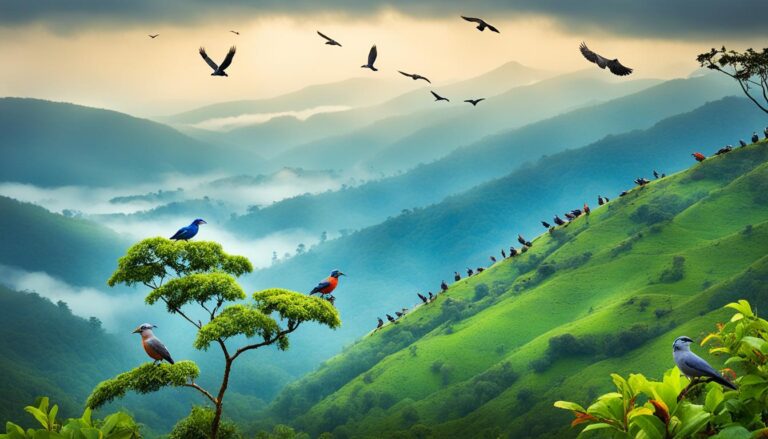Did you know the Western Ghats is a paradise for bird lovers? It’s home to over 500 bird species, with 16% found only here. This makes it a top spot for anyone who loves birds. From lush forests to misty high places, it offers an unmatched birdwatching adventure.
The Western Ghats is a birdwatcher’s dream. It has 29 species of birds that migrate or live here alone. Places like Hulivana Homestay let you see rare and beautiful birds up close in their natural setting.
Whether you’re an expert or just starting, the Western Ghats has something for you. Its varied landscapes support many bird types, making each visit an exciting new adventure. Get ready for a journey to one of the world’s best places for birdwatching!
Key Takeaways
- The Western Ghats is home to over 500 bird species
- 16% of bird species in the Western Ghats are endemic
- 29 documented migratory and endemic bird species
- Diverse habitats from lowland forests to high-altitude areas
- Hulivana Homestay offers an immersive birdwatching experience
- The region is a biodiversity hotspot for avian enthusiasts
Introduction to the Western Ghats
The Western Ghats is a UNESCO World Heritage Site, a mountain range along India’s western coast. It stretches across six states, offering a wide variety of ecosystems and habitats.
Geographical Overview
The Western Ghats run parallel to India’s western coast, from Gujarat to Tamil Nadu. This mountain range is over 1,600 kilometers long. It acts as a natural barrier between the coastal plains and the Deccan Plateau.
Biodiversity Hotspot
The Western Ghats is known as a biodiversity hotspot. It has an incredible variety of plants and animals. Many Western Ghats endemic species, including plants, animals, and birds, are found only here.
| Category | Total Species | Endemic Species |
|---|---|---|
| Plants | 7,402 | 5,588 |
| Mammals | 139 | 31 |
| Birds | 508 | 17 |
Importance for Birdwatching
For bird lovers, the Western Ghats is a dream come true. Its varied habitats support a rich bird population. This makes the Western Ghats bird sanctuaries a top spot for birdwatching.
From colorful endemic species to migratory birds, the Western Ghats offers great birdwatching all year.
“The Western Ghats is a birdwatcher’s dream, with its diverse landscapes and unique species. It’s a living laboratory of avian evolution and adaptation.”
The Rich Avian Diversity of Western Ghats
The Western Ghats is a paradise for bird lovers, with over 500 bird species. It’s a key spot for those on Western Ghats bird watching tours. This mountain range shows off the amazing variety of birds in the area.
In the Western Ghats, birdwatchers can see many unique birds. These birds live in different places like evergreen forests, grasslands, and sholas. They have adapted to these environments.
“The Western Ghats is a treasure trove for bird enthusiasts, offering glimpses of rare and beautiful species found nowhere else on Earth.” – Dr. Salim Ali, renowned ornithologist
Some notable endemic birds include:
- Kerala Laughingthrush
- Nilgiri Flycatcher
- White-bellied Blue Robin
- Malabar Grey Hornbill
- Wynaad Laughingthrush
The Western Ghats has different places that support many birds. This means birdwatchers can see birds all year round. It’s a great place for those who love birds.
| Habitat Type | Common Bird Species | Best Time to Visit |
|---|---|---|
| Evergreen Forests | Malabar Trogon, Great Hornbill | October – March |
| Grasslands | Nilgiri Pipit, Broad-tailed Grassbird | April – June |
| Wetlands | Indian Skimmer, Spot-billed Pelican | November – February |
Western Ghats bird watching tours are unforgettable for birders. You might see the elusive Spot-bellied Eagle Owl or the majestic Rufous-bellied Eagle. The region offers amazing sights and memories.
Best Seasons for Birdwatching in Western Ghats
The Western Ghats are great for birdwatching all year, but some seasons are better for certain birds. Knowing when to go can make your birdwatching trip better.
Winter Migration Patterns
Winter, from November to February, is the best time for birdwatching here. Many migratory birds come, making the area a lively place for bird lovers. You’ll see rare birds and get to experience a diverse birdwatching adventure.

Breeding Seasons
March to May is when many local birds breed. Birdwatchers can see birds mate, build nests, and see their young. The colors and sounds of breeding birds make birdwatching even more special.
Monsoon Considerations
The monsoon, from June to September, brings challenges and chances for birdwatchers. Heavy rains make some places hard to reach, but you might see rare birds. The greenery after the rain helps birds hide, making them fun to find.
| Season | Months | Birdwatching Highlights |
|---|---|---|
| Winter | November – February | Migratory birds, peak diversity |
| Breeding | March – May | Mating rituals, nesting activities |
| Monsoon | June – September | Elusive species, lush vegetation |
Plan your visit with these seasons in mind to see many birds in the Western Ghats. Each season has its own special birds and experiences. The Western Ghats is a great place for bird lovers all year.
Top Birdwatching Locations in the Western Ghats
The Western Ghats are a paradise for bird lovers. They have everything from lush forests to vast national parks. These places are home to some of India’s most beautiful bird sanctuaries. Let’s dive into the best spots for birders to enjoy the rich bird life.
Chinnar Wildlife Sanctuary is a top spot for birdwatching. It has different landscapes like dry forests and thorny scrub. Here, you can see colorful kingfishers, big raptors, and birds that come out at night.
Munnar and Valparai are great for birdwatching too. They are known for their tea plantations and shola forests. These places are home to special birds like the Nilgiri Pipit and White-bellied Shortwing.
Eravikulam National Park is famous for its Nilgiri Tahr. It’s also a great place for high-altitude birds. Birders can see the rare Nilgiri Laughingthrush and Black-and-Orange Flycatcher here.
Thattekad Bird Sanctuary is called the birdwatcher’s paradise. It has over 270 species of birds. This small sanctuary is perfect for spotting rare birds like the Ceylon Frogmouth and Malabar Trogon.
| Location | Key Species | Best Time to Visit |
|---|---|---|
| Chinnar Wildlife Sanctuary | Yellow-throated Bulbul, Indian Pitta | October to March |
| Munnar | Nilgiri Pipit, Kerala Laughingthrush | December to February |
| Valparai | Great Hornbill, Nilgiri Wood Pigeon | November to April |
| Eravikulam National Park | Nilgiri Laughingthrush, Black-and-Orange Flycatcher | April to June |
| Thattekad Bird Sanctuary | Ceylon Frogmouth, Malabar Trogon | October to March |
Hulivana Homestay in Sakleshpura, Karnataka, is a hidden gem for bird lovers. It’s an eco-friendly place that’s home to 29 types of birds. It’s a great spot for those looking for something different in the Western Ghats.
Endemic Bird Species of the Western Ghats
The Western Ghats is a paradise for bird lovers, with many unique birds found only here. These birds add to the region’s fame among birdwatchers. Let’s look at three amazing birds that live in this mountain range.
Kerala Laughingthrush
The Kerala Laughingthrush is a beautiful bird of the Western Ghats. Bird lovers can find it in dense forests near Top Station, close to Munnar. Its laugh-like call is a highlight for those exploring the area’s bird life.
Nilgiri Flycatcher
The Nilgiri Flycatcher is another special bird of the Western Ghats. It lives in high places, especially in Eravikulam National Park. Its bright blue color is a sight to see against the misty hills.
White-bellied Blue Robin
The White-bellied Blue Robin is our last bird to mention. It lives in the lower parts of the mountains. Birdwatchers might see it in Pampadum Shola National Park, where it sings a sweet song.
These birds show why we must protect the Western Ghats. Keeping their homes safe means more people can enjoy these birds in the future.
Birdwatching in Western Ghats: Essential Equipment and Tips
Starting a bird watching tour in the Western Ghats means you need the right gear and knowledge. Bring high-quality binoculars to see birds far away and a camera with a strong zoom for photos. Wear comfy clothes that suit the weather and are good for walking in different places.

A detailed field guide is key for identifying the many bird species you’ll see. Local guides who know the area can make your trip better. They help find hard-to-spot birds and share info about their behavior.
- Binoculars (8×42 or 10×42 recommended)
- Camera with zoom lens (at least 300mm)
- Field guide specific to Western Ghats birds
- Comfortable, moisture-wicking clothing
- Sturdy hiking boots
When birdwatching, timing is everything. The best times are early in the morning and late in the afternoon. Birds are usually most active then. Keep a safe distance from wildlife and follow park rules to protect their homes.
“The Western Ghats offer a symphony of birdsong for those who listen closely and tread lightly.”
Don’t forget to bring water, snacks, and sun protection. By using these tips and caring for the environment, your bird watching trip in the Western Ghats will be both fun and eco-friendly.
Conservation Efforts and Challenges
The Western Ghats are home to a wide variety of birds. They face big challenges in conservation. Protecting this area needs a plan that involves many people.
Habitat Preservation
Bird sanctuaries in the Western Ghats are key to protecting homes for many bird species. These places are safe for rare and unique birds. Plans are being made to grow and connect these areas to stop them from breaking into smaller pieces.
Community Involvement
Local communities are important for conservation. Villages near the Western Ghats offer birdwatching tours and places to stay. This helps spread the word about the birds and gives jobs to the people living there.
Sustainable Tourism
It’s hard to balance tourism and conservation. Using sustainable ways, like keeping visitor numbers low and birdwatching responsibly, helps. Some bird sanctuaries in the Western Ghats are doing this to protect the birds.
| Conservation Challenge | Current Efforts | Future Goals |
|---|---|---|
| Habitat Loss | Reforestation projects | Increase protected area by 20% |
| Climate Change | Monitoring species migration | Develop climate-resilient conservation plans |
| Human-Wildlife Conflict | Community education programs | Implement buffer zones around sanctuaries |
Even with efforts, challenges remain. Climate change, cutting down trees, and building cities are still threats. We need ongoing research and work together from conservationists, local people, and government to save this special place and its birds.
Planning Your Birdwatching Trip to the Western Ghats
Planning a birdwatching trip to the Western Ghats is exciting. This region is home to many birdwatching hotspots, each with its own unique species and habitats. Timing is key to enjoying your trip fully.
The best times for birdwatching depend on the species you want to see. Winter is great for migratory birds, while spring shows off their breeding plumage. Monsoon brings green landscapes but can make some areas hard to reach.
Many bird watching tours in the Western Ghats have expert guides and special itineraries. These tours visit top spots like Thattekad Bird Sanctuary and Silent Valley National Park. It’s a good idea to book early, especially when the birding is at its best.
There are many places to stay, from eco-lodges to homestays. Hulivana Homestay is perfect for birdwatchers, offering guides and easy access to birding areas.
| Birdwatching Hotspot | Key Species | Best Season |
|---|---|---|
| Thattekad Bird Sanctuary | Malabar Trogon, Ceylon Frogmouth | November to March |
| Silent Valley National Park | Great Indian Hornbill, Nilgiri Laughingthrush | December to April |
| Hulivana Homestay | Malabar Whistling Thrush, Flame-throated Bulbul | October to March |
Don’t forget to check if you need permits for certain areas and pack the right gear for the terrain and weather. With good planning, your trip to the Western Ghats for birdwatching will be unforgettable, filled with rare and beautiful birds.
Unique Birdwatching Experiences: From Hulivana to Eravikulam
The Western Ghats are a paradise for bird lovers and photographers. They offer exciting birding trails. From hidden spots to famous parks, it’s a dream destination.
Hulivana Homestay: A hidden gem for birders
Hulivana Homestay is a secret spot in the Western Ghats. It’s a cozy retreat with 29 bird species. The hosts are friendly and share their birding knowledge, making it great for all birdwatchers.
Eravikulam National Park: Home to rare species
Eravikulam National Park is a top spot for bird photography. It’s where you can see rare birds like the Nilgiri Pipit and Painted Bush Quail. The park’s varied habitats are perfect for capturing amazing photos of these birds.
Nocturnal birding adventures
Night birding in the Western Ghats is an adventure. You might see owls like the Brown Hawk Owl or Indian Scops Owl. For unique sightings, visit Villoni Estate for the Great Hornbill or Longwood Shola National Park for the Rufous-bellied Robin.
AI:
Unique Birdwatching Experiences: From Hulivana to Eravikulam
The Western Ghats are full of birding wonders, from hidden spots to famous parks. These places offer great chances for bird lovers and photographers to see India’s amazing birds.
Hulivana Homestay: A hidden gem for birders
Hulivana Homestay is a bird lover’s dream in the Western Ghats. It has 29 bird species. The hosts know a lot about birds and guide visitors through the forests, making it perfect for all birdwatchers.
Eravikulam National Park: Home to rare species
Eravikulam National Park is a top spot for bird photography. It has rare birds like the Nilgiri Pipit and Painted Bush Quail. The park’s beautiful landscapes are great for taking photos of these birds.
Nocturnal birding adventures
At night, the Western Ghats come alive with birds. You can see owls like the Brown Hawk Owl and Indian Scops Owl. For special sightings, go to Villoni Estate for the Great Hornbill or Longwood Shola National Park for the Rufous-bellied Robin.
